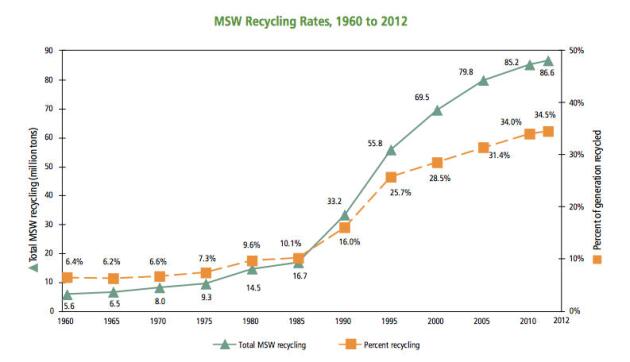Helping Solve the Municipal Waste Crisis
That empty pizza box, those grass clippings, your musty old sofa— various items we generally refer to as "trash"— actually have a much fancier name: Municipal Solid Waste (MSW). This includes anything we commonly use and then throw away, recycle, or compost. We probably rarely consider the afterlife of our garbage, but the U.S. Environmental Protection Agency keeps track of MSW and what happens when it's been tossed. Why? Because all our stuff needs to be transported and ultimately put to rest, a process that takes a huge toll on our environment. Recycling is the least harmful option, but the large majority of waste ends up in a landfill or incinerator.
Unfortunately, the amount of trash we create has been increasing over time. The EPA's most recent report shows that the amount of MSW generated per day per person was only 2.68 pounds in 1960, but since the 1990's it has increased to about 4 pounds per person per day. On the bright side, there have been small strides made not only in reducing the amount of waste we produce, but also in recycling it.
Clothes are often overlooked as a reusable item, either because people assume they can't be reused or they are not accepted by municipal recycling programs. The percentage of our waste composed of textiles has more than doubled since the 1960s, and only 15.7 percent of all textiles are recovered after being thrown away, but keeping them out of landfills can have significant environmental benefits. For example, the two million tons of textiles that were recycled in 2012 helped reduce greenhouse gases in the same capacity as taking 1.2 million cars off the road.
There's also an economic incentive for recycling your old clothes. For example, Re-Purpose New Jersey estimates that landfill disposal costs an average $60 per ton, meaning that the 86.62 million tons of waste diverted in 2012 saved taxpayers over five billion dollars.
Planet Aid recognizes the role that convenience plays in recycling. Most areas of the country have curbside recycling programs for paper, plastics, and glass, but very few have simple solutions for repurposing clothes. We strive to make the donating process require as little effort on your part as possible. It's as easy as dropping a bag off at one of the local gas stations that host our bins, all with the peace of mind that you're helping offset your carbon footprint (even while filling up your tank).
We have thousands of yellow Planet Aid bins in 21 states where you can donate unwanted shirts, pants, shoes, coats, and shoes that you don't wear anymore. Even old socks and underwear can be remanufactured as wiping cloths, insulation fiber, or paper products (please launder them before donating).
Whether you call it Municipal Solid Waste, trash, junk, or garbage, remember that it can almost always be reused.

